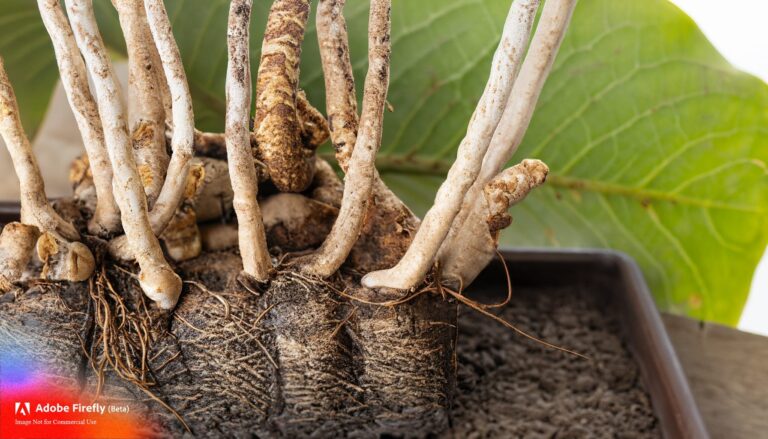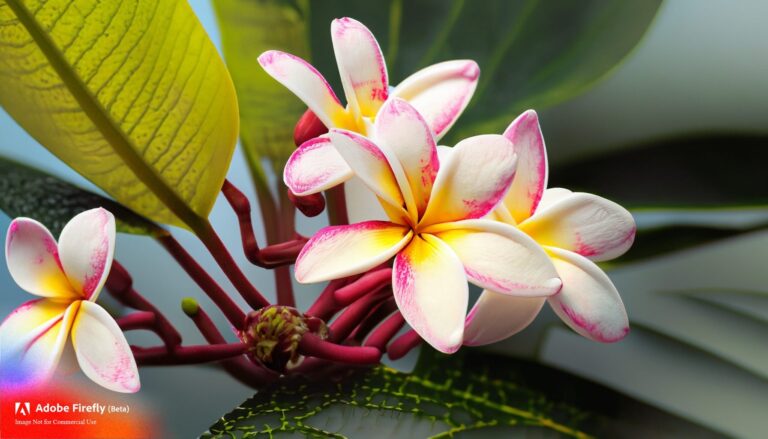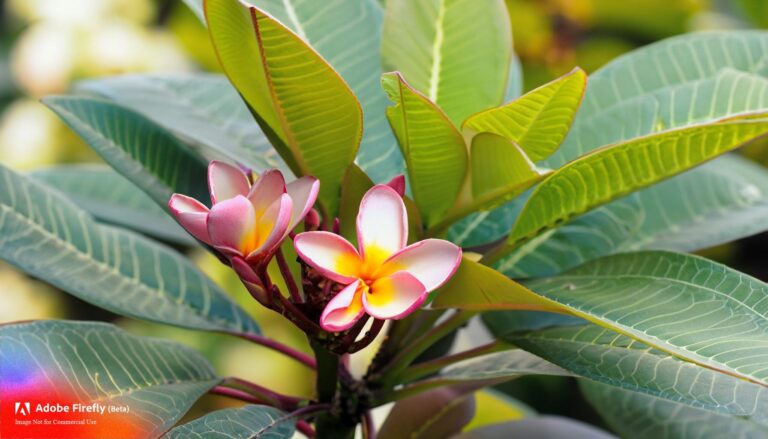
Plumerias have specific sun and light requirements to thrive and promote optimal growth and flowering. Here is a guide to understanding their sun and light needs:
- Full Sun: Plumerias require full sun to flourish and produce abundant blooms. They need at least 6 to 8 hours of direct sunlight per day. Place your plumeria in a location that receives ample sunlight, such as a south-facing area in your garden or patio. If growing indoors, position the plant near a south-facing window or use grow lights to provide sufficient light.
- Sunlight Intensity: Along with duration, the intensity of sunlight is also crucial for plumerias. Ensure they receive strong, direct sunlight rather than filtered or dappled light. Direct sunlight provides the energy necessary for vigorous growth and prolific flowering.
- Partial Shade: While plumerias prefer full sun, they can tolerate some degree of partial shade, especially in extremely hot climates or during the peak of summer. However, it’s important to strike a balance and ensure they still receive a significant amount of direct sunlight. Too much shade can result in reduced flowering and elongated, leggy growth.
- Sun Protection: In regions with scorching temperatures or intense sunlight, some protection may be necessary. You can provide temporary shading during the hottest part of the day using umbrellas, shade cloth, or structures like pergolas. This can help shield the plumeria from excessive heat and prevent sunburn.
- Orientation: Plumerias benefit from proper orientation to the sun. In the Northern Hemisphere, placing them on the southern side of buildings or structures provides maximum exposure to the sun’s path. This ensures even sunlight distribution and promotes balanced growth.
- Seasonal Adjustments: During the winter months or in regions with cold climates, plumerias may enter a period of dormancy. At this time, they require reduced sunlight and cooler temperatures. Move potted plumerias indoors or provide protection from frost while maintaining a cool environment. Limit their exposure to sunlight during this dormancy period.
By meeting the sun and light requirements of your plumerias, you can create optimal growing conditions and encourage healthy growth, abundant blooms, and overall plant vitality.
Can Plumeria Grow In Shade?
Plumerias prefer full sun and thrive best when grown in direct sunlight. However, they can tolerate some degree of shade, depending on the specific conditions. Plumerias grown in shade may have reduced flower production and slower growth compared to those grown in full sun. If you have limited sunlight available, you can still try growing plumerias in areas with partial shade or areas that receive a few hours of direct sunlight per day.
It’s important to strike a balance and provide the maximum amount of sunlight possible within the available conditions to promote healthier growth and more abundant blooming. If growing plumerias in shade, monitor the plant closely and consider supplementing with appropriate lighting or moving the plant to a sunnier location if necessary.
Does Plumeria Need Sun Or Shade?
Plumerias require sun, specifically full sun, to thrive and produce optimal growth and flowering. They are sun-loving plants that benefit from direct sunlight for at least 6 to 8 hours per day. Plumerias grown in full sun conditions tend to have healthier foliage, stronger stems, and produce more abundant and vibrant blooms.
While plumerias can tolerate some shade, excessive shade can negatively affect their growth and flowering potential. Therefore, it is recommended to provide plumerias with as much direct sunlight as possible to ensure their overall health and maximize their blooming potential.
Can Champa Grow In Shade?
Champa, which is another name for plumeria, prefers full sun and thrives best when grown in direct sunlight. However, champa plants can tolerate some degree of shade, depending on the specific conditions. If you have limited sunlight available, you can still attempt to grow champa in areas with partial shade or areas that receive a few hours of direct sunlight per day.
Remember that champa plants grown in shade may have reduced flower production and slower growth compared to those grown in full sun. It’s important to provide the maximum sunlight possible within the available conditions to promote healthier growth and encourage blooming. If growing Champa in the shade, monitor the plant closely and consider supplementing with appropriate lighting or moving the plant to a sunnier location if necessary.
How Much Sunlight Do Plumeria Trees Need?
Plumeria trees thrive when they receive full sun exposure, typically at least 6 to 8 hours of direct sunlight per day. The more sunlight they receive, the better their growth, flowering, and overall health. Plumerias are sun-loving plants, and direct sunlight provides them with the necessary energy for photosynthesis and robust growth.
When planted in an area with ample sunlight, plumeria trees tend to have stronger stems, and larger leaves and produce more abundant and vibrant blooms. If you are considering planting plumeria trees, ensure that the location provides maximum sun exposure throughout the day to support their optimal growth and blooming potential.
Can Plumeria Grow In Indirect Sunlight?
While plumerias prefer full sun and direct sunlight, they can tolerate some degree of indirect sunlight. Indirect sunlight refers to sunlight that is filtered, diffused, or partially blocked by objects such as trees, buildings, or sheer curtains. Plumerias can still grow in areas with indirect sunlight, but it’s important to note that their growth and flowering may be impacted.
Plumerias grown in indirect sunlight may experience slower growth and potentially produce fewer blooms compared to those grown in full sun. They may also develop elongated and leggy growth as they reach towards the available light source. The intensity and duration of indirect sunlight will determine the extent to which the plumerias can thrive.
If growing plumerias in areas with indirect sunlight, consider the following:
- Maximize available light: Place the plumeria in the brightest area possible within the given conditions to ensure they receive the maximum amount of indirect sunlight.
- Supplement with artificial lighting: If the available natural light is limited, you can supplement with grow lights to provide additional light and mimic full sun conditions.
- Monitor plant health: Keep a close eye on the plumeria’s growth and overall health. If you notice signs of stretching, weak growth, or reduced flowering, it may indicate that the plant is not receiving sufficient light.
While plumerias can tolerate indirect sunlight for short periods, it’s still ideal to provide them with as much direct sunlight as possible to promote optimal growth, foliage health, and abundant blooming.
Should Plumerias Be In Direct Sunlight?
When plumerias are grown in direct sunlight, they typically have stronger stems, larger and healthier leaves, and produce more vibrant and abundant blooms. Full sun exposure allows plumerias to develop their signature tropical beauty and fragrance.
While plumerias can tolerate some shade or indirect sunlight, their growth and flowering may be affected. Plumerias grown in shade or low-light conditions may exhibit weaker growth, reduced flower production, and elongated stems as they stretch towards the available light.
To ensure the best results with your plumerias, it is recommended to place them in a location that receives ample direct sunlight throughout the day. This will support their overall health, growth, and blooming potential.






